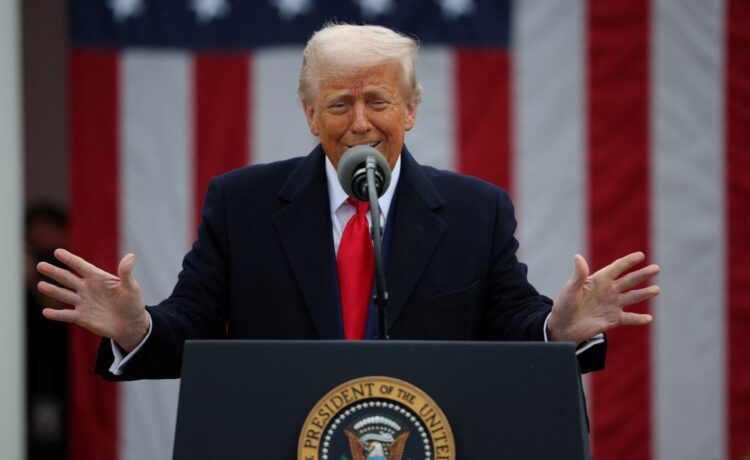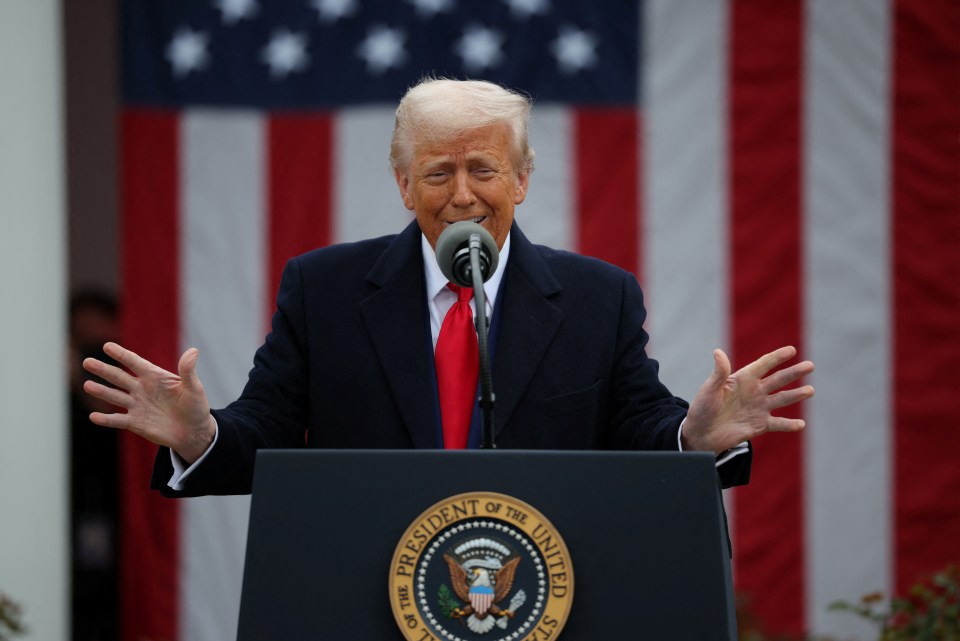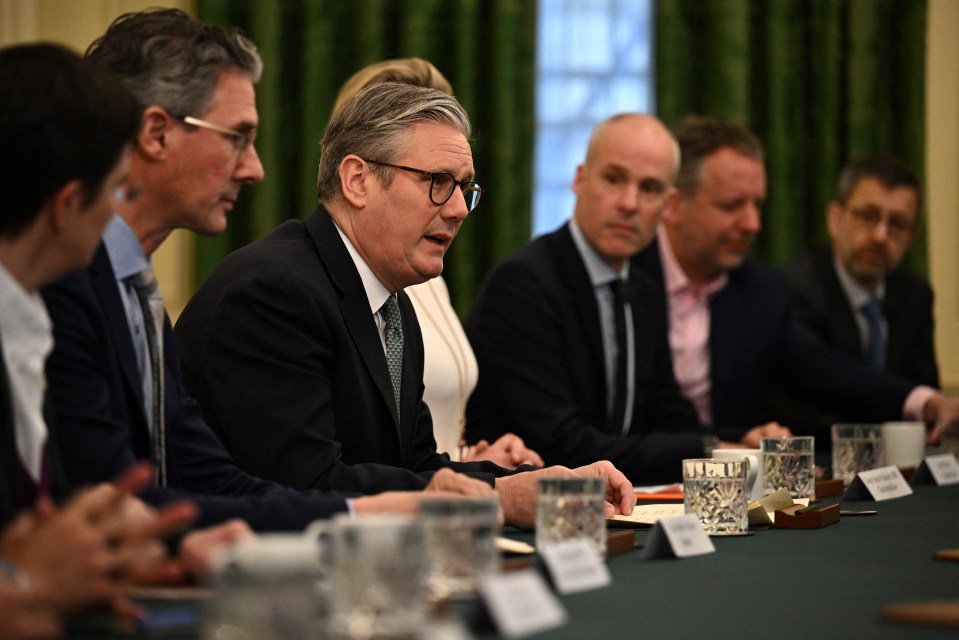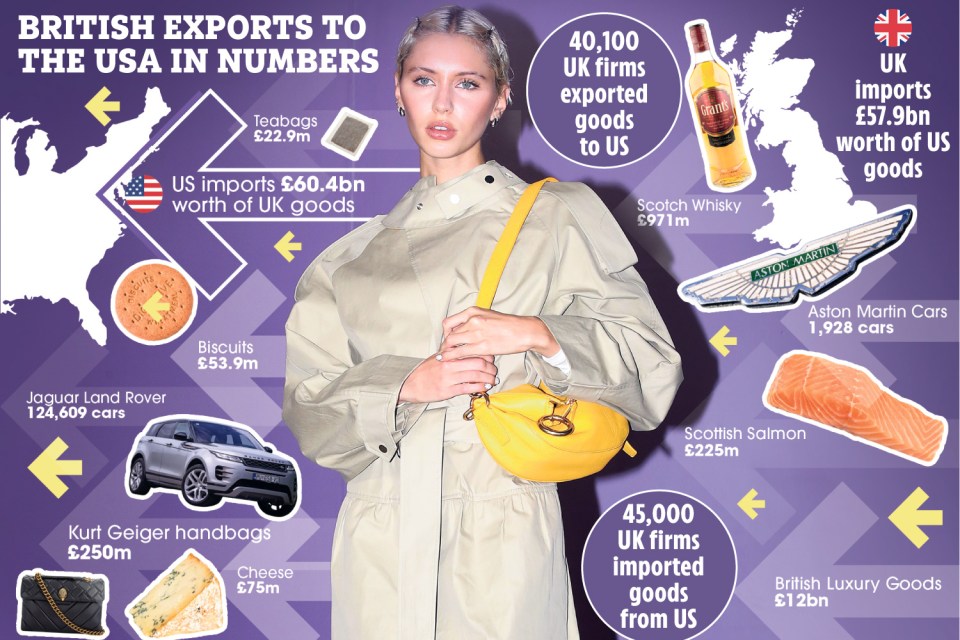TRUMP’S punishing tariffs have triggered a global stock market meltdown of the kind not seen since the start of pandemic lockdowns in March 2020.
A market rout that started in Asia in reaction to hefty tariffs on China, Japan and Taiwan has rippled with trillions of dollars already wiped off.
Shortly after China announced it would retaliate with 34 per cent tariffs on US goods London’s biggest index of the most 100 valuable UK companies tanked by 3.8 per cent, or 321 points, to 8152.31 points – the steepest one day fall in five years.
The FTSE 250 – which measures midcap listed companies and is seen as the best reflection of the UK economy – has also tumbled by 3.9 per cent, or 766.61 points, to 8150.37 points.
To put it into context, the market reaction is more frightening than when Russia invaded Ukraine in 2022.
There’s little signs of the market sell-off getting better either.
SO HOW SHOULD BRITS PROTECT THEIR MONEY AND PENSIONS?
For those a little way off retirement, advisers are urging Brits not to panic.
Typically most pension pots are managed with a mix of shares, bonds and other assets – this is a deliberate strategy to try to cushion against future hefty stock market crashes.
While stock markets are falling, bonds prices are rising as investors switch their bets.
If you’re in a defined benefit pension plan, which is now much more common for public sector workers than in private business, these typically are run even more conservatively to ensure payout obligations are met when workers retire.
For those in defined contribution pension plans – which are topped up monthly via payslip contributions from employees and employers – it might be worth checking how your pot is managed and if it is heavily invested in one area.
But it is important to not just stop investing – pension contributions are a tax free way of saving for the future.
One option could be to direct pension managers to increase exposure to bonds, or to infrastructure funds which are generally less risky and have stable levels of returns.
The problem is that for years British pension funds have been piling into US shares, which have outperformed the rest of the world.
This is particularly true of the big tech firms, which have soared in value.
As a result about 45 per cent of assets DC pension schemes are invested in US stocks and these shares are collapsing in value.
While Chancellor Rachel Reeves wants our pension funds to invest more heavily in the London stock market, at the moment that’s not such a safe bet as the FTSE 100 has tanked so heavily.
Pension funds typically invest heavily in the bigger firms, such as Barclays, Shell, BP – all of which have suffered big falls.
SO WHERE’S SAFE?
Think about investing in so-called “essential” stocks and safe havens. Utility companies, such as the power companies such as SSE and National Grid, will be in demand as we will still need energy.
National Grid also has a big business in the US.
Food retailers are also holding up relatively well with shares in Tesco, Marks & Spencer and Sainsbury’s not being hit by the sell-off.
Consumers will still need to eat, and as we saw during the pandemic and cost of living crisis, inflation has typically helped their profits too.
Tobacco stocks will also be back in fashion, partly because in times of stress more people spark up and smoke.
Gold has already had an astonishing rally and keeps breaking record highs, with the current prices now above $3,127.
However, with threats of a global trade war intensifying, there will be even greater demand for safe havens.
For canny investors the other idea is to bet on British businesses which have large manufacturing sites in America already.
The idea is that these firms will still be able to protect their profits by escaping tariffs when selling US made products to US consumers.
Analysts at AJ Bell have come up with a list of FTSE 100 firms including catering firm Compass, which has more than two-thirds of its facilities in the US.
Defence firm BAE Systems has 59 per cent of its facilities in the US. Medical device firm Convatec also has 40 per cent of its manufacturing sites in the US while testing business Intertek has 46 per cent.
President Trump’s Reciprocal Tariffs
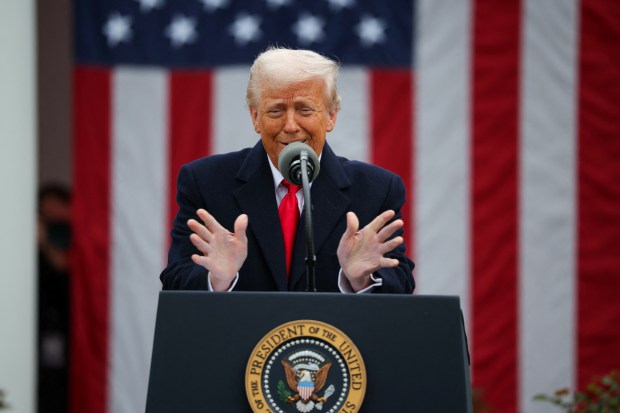
President Trump unveiled his reciprocal tariff plan on countries worldwide on April 2, which he declared as “Liberation Day”.
Reciprocal tariffs per country, which includes the 10% baseline fee:
- China: charges the US 67% tariffs, the US will counter with 34% reciprocal tariffs.
- European Union: charges the US 39% tariffs, the US will counter with 20% reciprocal tariffs.
- Vietnam: charges the US 90% tariffs, the US will counter with 46% reciprocal tariffs.
- Taiwan: charges the US 64% tariffs, the US will counter with 32% reciprocal tariffs.
- Japan: charges the US 46% tariffs, the US will counter with 24% reciprocal tariffs.
- India: charges the US 52% tariffs, the US will counter with 26% reciprocal tariffs.
- South Korea: charges the US 50% tariffs, the US will counter with 25% reciprocal tariffs.
- Thailand: charges the US 72% tariffs, the US will counter with 36% reciprocal tariffs.
- Switzerland: charges the US 61% tariffs, the US will counter with 31% reciprocal tariffs.
- Indonesia: charges the US 61% tariffs, the US will counter with 32% reciprocal tariffs.
- Malaysia: charges the US 47% tariffs, the US will counter with 24% reciprocal tariffs.
- Cambodia: charges the US 97% tariffs, the US will counter with 49% reciprocal tariffs.
- United Kingdom: charges the US 10% tariffs, the US will counter with 10% reciprocal tariffs.
- South Africa: charges the US 60% tariffs, the US will counter with 30% reciprocal tariffs.
- Brazil: charges the US 10% tariffs, the US will counter with 10% reciprocal tariffs.
- Bangladesh: charges the US 74% tariffs, the US will counter with 37% reciprocal tariffs.
- Singapore: charges the US 10% tariffs, the US will counter with 10% reciprocal tariffs.
- Israel: charges the US 33% tariffs, the US will counter with 17% reciprocal tariffs.
- Philippines: charges the US 34% tariffs, the US will counter with 17% reciprocal tariffs.
- Chile: charges the US 10% tariffs, the US will counter with 10% reciprocal tariffs.
- Australia: charges the US 10% tariffs, the US will counter with 10% reciprocal tariffs.
- Pakistan: charges the US 58% tariffs, the US will counter with 29% reciprocal tariffs.
- Turkey: charges the US 10% tariffs, the US will counter with 10% reciprocal tariffs.
- Sri Lanka: charges the US 88% tariffs, the US will counter with 44% reciprocal tariffs.
- Colombia: charges the US 10% tariffs, the US will counter with 10% reciprocal tariffs.
- Peru: charges the US 10% tariffs, the US will counter with 10% reciprocal tariffs.
- Nicaragua: charges the US 36% tariffs, the US will counter with 18% reciprocal tariffs.
- Norway: charges the US 30% tariffs, the US will counter with 15% reciprocal tariffs.
- Costa Rica: charges the US 17% tariffs, the US will counter with 10% reciprocal tariffs.
- Jordan: charges the US 40% tariffs, the US will counter with 20% reciprocal tariffs.
- Dominican Republic: charges the US 10% tariffs, the US will counter with 10% reciprocal tariffs.
- United Arab Emirates: charges the US 10% tariffs, the US will counter with 10% reciprocal tariffs.
- New Zealand: charges the US 20% tariffs, the US will counter with 10% reciprocal tariffs.
- Argentina: charges the US 10% tariffs, the US will counter with 10% reciprocal tariffs.
- Ecuador: charges the US 12% tariffs, the US will counter with 10% reciprocal tariffs.
- Guatemala: charges the US 10% tariffs, the US will counter with 10% reciprocal tariffs.
- Honduras: charges the US 10% tariffs, the US will counter with 10% reciprocal tariffs.
- Myanmar (Burma): charges the US 88% tariffs, the US will counter with 44% reciprocal tariffs.
- Tunisia: charges the US 55% tariffs, the US will counter with 28% reciprocal tariffs.
- Kazakhstan: charges the US 54% tariffs, the US will counter with 27% reciprocal tariffs.
- Serbia: charges the US 74% tariffs, the US will counter with 37% reciprocal tariffs.
- Egypt: charges the US 10% tariffs, the US will counter with 10% reciprocal tariffs.
- Saudi Arabia: charges the US 10% tariffs, the US will counter with 10% reciprocal tariffs.
- El Salvador: charges the US 10% tariffs, the US will counter with 10% reciprocal tariffs.
- Côte d’Ivoire: charges the US 41% tariffs, the US will counter with 21% reciprocal tariffs.
- Laos: charges the US 95% tariffs, the US will counter with 48% reciprocal tariffs.
- Botswana: charges the US 74% tariffs, the US will counter with 37% reciprocal tariffs.
- Trinidad and Tobago: charges the US 12% tariffs, the US will counter with 10% reciprocal tariffs.
- Morocco: charges the US 10% tariffs, the US will counter with 10% reciprocal tariffs.
- Moldova: charges the US 61% tariffs, the US will counter with 31% reciprocal tariffs.
- Angola: charges the US 63% tariffs, the US will counter with 32% reciprocal tariffs.
- Democratic Republic of the Congo: charges the US 22% tariffs, the US will counter with 11% reciprocal tariffs.
- Jamaica: charges the US 10% tariffs, the US will counter with 10% reciprocal tariffs.
- Mozambique: charges the US 31% tariffs, the US will counter with 16% reciprocal tariffs.
- Paraguay: charges the US 10% tariffs, the US will counter with 10% reciprocal tariffs.
- Zambia: charges the US 33% tariffs, the US will counter with 17% reciprocal tariffs.
- Lebanon: charges the US 10% tariffs, the US will counter with 10% reciprocal tariffs.
- Tanzania: charges the US 10% tariffs, the US will counter with 10% reciprocal tariffs.
- Iraq: charges the US 78% tariffs, the US will counter with 39% reciprocal tariffs.
- Georgia: charges the US 10% tariffs, the US will counter with 10% reciprocal tariffs.
- Senegal: charges the US 10% tariffs, the US will counter with 10% reciprocal tariffs.
- Azerbaijan:charges the US 10% tariffs, the US will counter with 10% reciprocal tariffs.
- Cameroon: charges the US 22% tariffs, the US will counter with 11% reciprocal tariffs.
- Uganda: charges the US 20% tariffs, the US will counter with 10% reciprocal tariffs.
- Albania: charges the US 10% tariffs, the US will counter with 10% reciprocal tariffs.
- Armenia: charges the US 10% tariffs, the US will counter with 10% reciprocal tariffs.
- Nepal: charges the US 10% tariffs, the US will counter with 10% reciprocal tariffs.
- Sint Maarten: charges the US 10% tariffs, the US will counter with 10% reciprocal tariffs.
- Falkland Islands: charges the US 82% tariffs, the US will counter 41% with reciprocal tariffs.
- Gabon: charges the US 10% tariffs, the US will counter with 10% reciprocal tariffs.
- Kuwait: charges the US 10% tariffs, the US will counter with 10% reciprocal tariffs.
- Togo: charges the US 10% tariffs, the US will counter with 10% reciprocal tariffs.
- Suriname: charges the US 10% tariffs, the US will counter with 10% reciprocal tariffs.
- Belize: charges the US 10% tariffs, the US will counter with 10% reciprocal tariffs.
- Algeria: charges the US 59% tariffs, the US will counter with 30% reciprocal tariffs.
- Oman: charges the US 10& tariffs, the US will counter with 10% reciprocal tariffs.
- Uruguay: charges the US 10% tariffs, the US will counter with 10% reciprocal tariffs.
- Bahamas: charges the US 10% tariffs, the US will counter with 10% reciprocal tariffs.
- Lesotho: charges the US 99% tariffs, the US will counter with 55% reciprocal tariffs.
- Ukraine: charges the US 10% tariffs, the US will counter with 10% reciprocal tariffs.
- Bahrain: charges the US 10% tariffs, the US will counter with 10% reciprocal tariffs.
- Qatar: charges the US 10% tariffs, the US will counter with 10% reciprocal tariffs.
- Mauritius: charges the US 80% tariffs, the US will counter with 40% reciprocal tariffs.
- Fiji: charges the US 63% tariffs, the US will counter with 32% reciprocal tariffs.
- Iceland: charges the US 10% tariffs, the US will counter with 10% reciprocal tariffs.
- Kenya: charges the US 10% tariffs, the US will counter with 10% reciprocal tariffs.
- Liechtenstein: charges the US 73% tariffs, the US will counter with 37% reciprocal tariffs.
- Guyana: charges the US 76% tariffs, the US will counter with 38% reciprocal tariffs.
- Haiti: charges the US 10% tariffs, the US will counter with 10% reciprocal tariffs.
- Bosnia and Herzegovina: charges the US 70% tariffs, the US will counter with 35% reciprocal tariffs.
- Nigeria: charges the US 27% tariffs, the US will counter with 14% reciprocal tariffs.
- Namibia: charges the US 42% tariffs, the US will counter with 21% reciprocal tariffs.
- Brunei: charges the US 47% tariffs, the US will counter with 24% reciprocal tariffs.
- Bolivia: charges the US 20% tariffs, the US will counter with 10% reciprocal tariffs.
- Panama: charges the US 10% tariffs, the US will counter with 10% reciprocal tariffs.
- Venezuela: charges the US 29% tariffs, the US will counter with 15% reciprocal tariffs.
- North Macedonia: charges the US 65% tariffs, the US will counter 33% with reciprocal tariffs.
- Ethiopia: charges the US 10% tariffs, the US will counter with 10% reciprocal tariffs.
- Ghana: charges the US 17% tariffs, the US will counter with 10% reciprocal tariffs.
The full list was shared by The White House’s rapid response team on X.
WHAT’S HAPPENED TO THE UK?
The UK has been hit by a 10 per cent tariff – what the White House calls the baseline rate – on all goods imported into the United States.
But it’s bad news for British car makers as Trump confirmed all foreign car imports will be subject to a further 25 per cent tariff.
The US imports £60.4billion British goods, fractionally more than the £57.9billion the UK imports from America.
The UK has been given the lowest rate of tariff.
By comparison China has been hit with a 34 per cent “reciprocal tariff” – half the 67 per cent rate Trump claims China charges US importers.
However, added to the existing rate of tariffs on China, it takes the levy up to 50 per cent.
Vietnam, where many Western companies have factories, will now face a 46 per cent tariff.
Japan is hit with 24 per cent and Taiwan faces 32 per cent.
WHAT IS A TARIFF?
In effect, it is a tax on foreign goods coming into a country.
It is paid by the company which imports goods, to the country’s government.
Most tariffs are set as a percentage of the value of the goods.
Tariff hit causing mixed feelings in government
By Jack Elsom, Chief Political Correspondent
BRITAIN’S 10 per cent tariff hit is causing mixed feelings in the upper echelons of government today.
Yes, it was the lowest levy doled out by Donald Trump and far below that imposed on many other countries.
But it will still hurt the UK economy, whack our exporters and likely cost scores of jobs.
And what of this charm offensive Sir Keir Starmer has attempted to get in the US President’s good books?
Downing Street was quick to trumpet this approach – and the refusal to retaliate – as “vindication” we have escaped lightly from the tariff blizzard.
Yet many other countries have also been given the 10 per cent levy, including Brazil which has put in far less legwork with the White House than our government.
Ministers will be desperate now to sign this fabled economic deal in the hope it will do away with tariffs entirely.
One thing is undeniable: being outside the European Union has spared us being doubly worse off.
The 20 per cent tariff slung around the Brussels bloc would have been our fate should Brexit had not happened.
EU chief Ursula Von der Leyen has vowed to retaliate – which would have dragged us into a trade war with our closest ally if we were still a member.
It’s not a pretty situation, but it could be a whole lot worse…
For example, a 10 per cent tariff would mean a charge of $5 on a $500 handbag while a 25 per cent tariff on a $40,000 car would be a $10,000 hit.
Typically it makes the price of that product more expensive as the tariff is passed straight onto consumers.
Tariffs have the specific purpose of giving home grown companies an advantage over foreign producers trying to sell goods in a market.
WHY IS TRUMP DOING THIS?
Trump has long been a fan of tariffs – infamously describing them as the “most beautiful word in the dictionary”.
He has raged for years about the unfairness of other countries slapping taxes on the import of US goods, with the EU a particular target of his rage after flooding the American market with BMW and Mercedes cars.
Last night he stepped up his attack accusing countries of “looting, raping and pillaging” America.
Trump believes that introducing tariffs will encourage more companies to build factories in America to avoid tariffs, and that US consumers will be more likely to buy “made in America” products if they are cheaper as a result of being tariff-free.
He said that these tariffs will “Make America Wealthy Again”.
HOW WILL THIS HIT THE ECONOMY?
Britain’s already fragile growth will be almost immediately dented by all this uncertainty.
The Budget watchdog had previously warned it could wipe out UK economic growth by 1 per cent and wipe out the £9.9billion headroom so carefully reinstated by the Chancellor just last week.
This could mean further tax rises or even deeper spending cuts.
What is the FTSE and what does it say about Britain’s economy?
The UK’s biggest stock market index arrived in January 1984 at a time when traders still gave instructions in big mobile phones.
The FTSE 100 is made up of the 100 biggest publicly traded companies on the London Stock Exchange.
It is usually used as a measure of wealth and a guide of how the UK is doing relative to other stock markets.
Being included in it still has merit as it ranks the most valuable listed UK companies and it means firms get an instant lift from tracker funds that follow it.
The stock markets – which many of our pension funds invest in – have also tanked this morning.
London‘s FTSE 100 index sank by 1 per cent, the FTSE 250 – which ranks mid-cap sized listed companies – down by 0.82 per cent.
The slump in stock markets, such as the FTSE 100, can be read as investors increasingly pessimistic views about the state of those countries’ economies.
European stock markets in France and Germany fell even more heavily.
In Japan the Nikkei index has dropped by 2.77 per cent.
In short a sea of flashing red lights on global stock markets. Meanwhile more investors are piling into gold, which is seen as a safer asset, and prices are back at record highs of over $3,1000 an ounce.
JOB LOSSES
There are huge fears that the tariffs will lead to job losses.
As well as hiking prices, companies will have to make significant cost cuts to survive the pressure from extra duties.
More than 25,000 jobs in the motor industry are thought to be at risk from Trump’s 25 per cent tariff on car imports, according to the Institute For Public Policy Research.
Around 17 per cent of UK car exports were to the US last year , worth £7.6billion.

